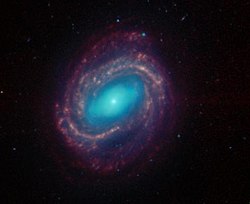| Messier 58 | |
|---|---|
 | |
| Observation data (J2000 epoch) | |
| Constellation | Virgo [1] |
| Right ascension | 12h 37m 43.522s [2] |
| Declination | +11° 49′ 05.498″ [2] |
| Redshift | 0.00506 [2] [3] |
| Heliocentric radial velocity | 1517 ± 1 km/s [2] [3] |
| Distance | 21 megaparsecs (68 million light-years) [2] [4] |
| Apparent magnitude (V) | 9.7 [5] |
| Characteristics | |
| Type | SAB(rs)b; LINER [6] Sy 1.9 [2] [7] |
| Size | 40.72 kiloparsecs (133,000 light-years) diameter; 2MASS K-band total isophote [2] [8] |
| Apparent size (V) | 5.9′ × 4.7′ [2] |
| Other designations | |
| NGC 4579, UGC 7796, PGC 42168, VCC 1727, GC 3121 [2] | |
Messier 58 (also known as M58 and NGC 4579) is an intermediate barred spiral galaxy with a weak inner ring structure located within the constellation Virgo, approximately 68 million light-years away from Earth. [9] [10] It was discovered by Charles Messier on April 15, 1779 and is one of four barred spiral galaxies that appear in Messier's catalogue. [11] [12] [13] [14] [15] [Note 1] M58 is one of the brightest galaxies in the Virgo Cluster. [16] [17] From 1779 it was arguably (though unknown at that time) the farthest known astronomical object [18] until the release of the New General Catalogue in the 1880s and even more so the publishing of redshift values in the 1920s.

